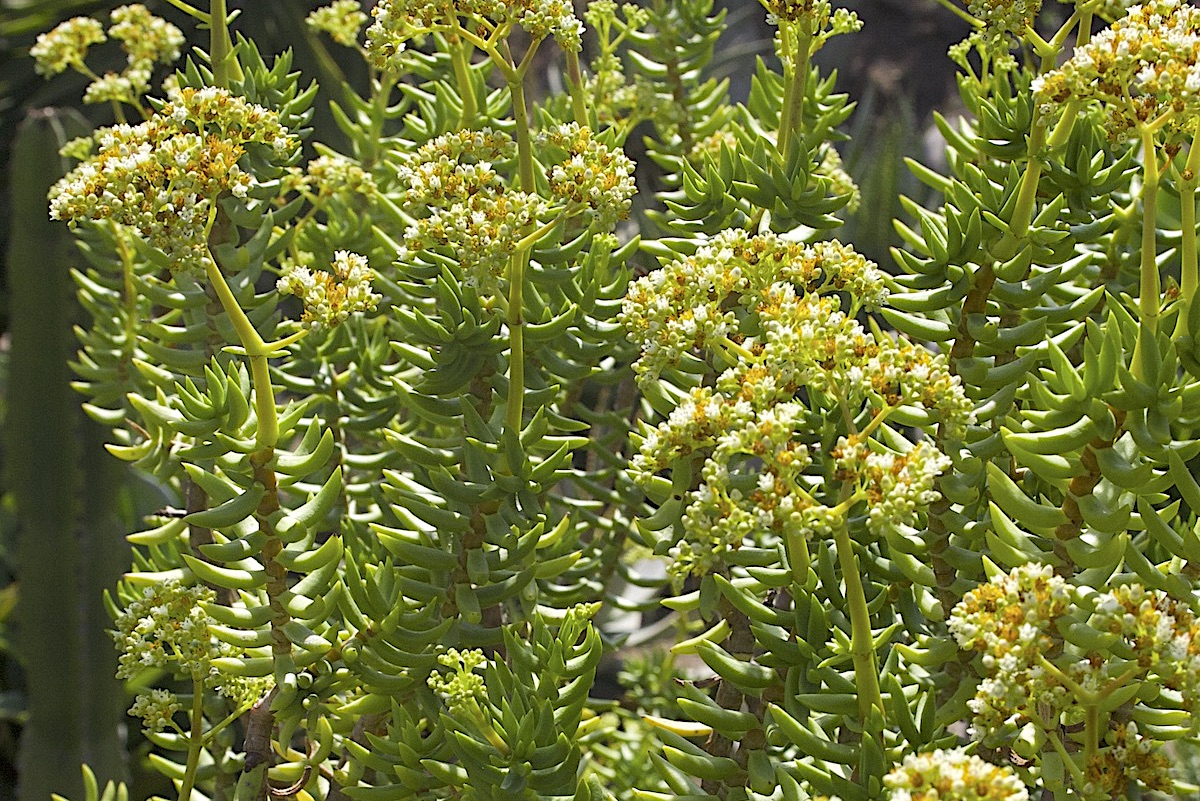
Grow Versatile “Mini Pine Tree” Crassula
Mini pine tree crassula, like its relative jade, is a carefree succulent I've grown for 20+ years. The botanical name, Crassula tetragona, refers to the three-sided shape of the leaves.

Crassula tetragona at left, with blue Senecio mandraliscae and aeoniums in bloom.
As the name implies, stems of this succulent resemble a pine tree. Along upright stalks grow slender, pointed green leaves that curve up slightly and are smaller toward the top. Over time, rooted cuttings may branch, forming a shrub.
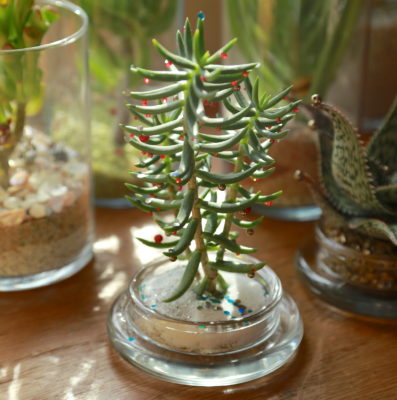
I glued beads to Crassula tetragona leaf tips for a holiday display. Find out how I made it.
Cuttings establish easily. As with most stem succulents, cut off the top few inches and insert cuttings upright in soil.
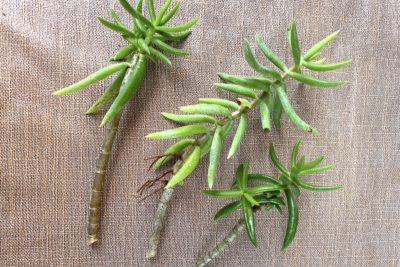
Note how roots have started to emerge from the stem of the middle cutting.
When planting cuttings, make sure the bands on the trunks (where old leaves once were attached) are buried. From those bands, new roots will form.
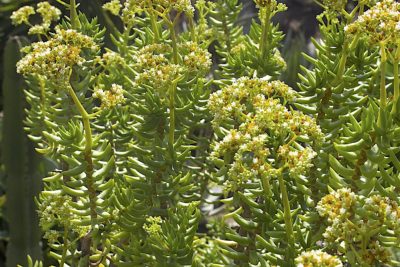
Typical of crassulas, mini pine tree produces clusters of dainty flowers.
It seems less frost tender than jades (Crassula ovata and cultivars). In my garden, mini pine tree plants have been undamaged when temps have dropped into the 20s F. It forms a polite green bush, not too large (2 to 3 feet tall and as wide), with a textural silhouette.
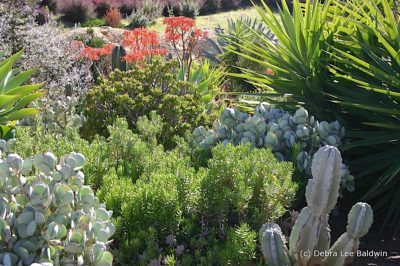
Crassula tetragona, foreground, in a Southern CA garden that includes aloes in bloom, yuccas and jade.
Like jade, it's a great garden filler plant, but is arguably more interesting. Certainly, it's not as common.

Crassula tetragona adds height, texture and interest to a succulent container garden
Because Crassula tetragona looks like little fir trees, cuttings are a perfect addition to miniature succulent gardens. One example is the Guatemalan mountain scene on pages 122-123 of my book, Designing with Succulents (2nd ed).
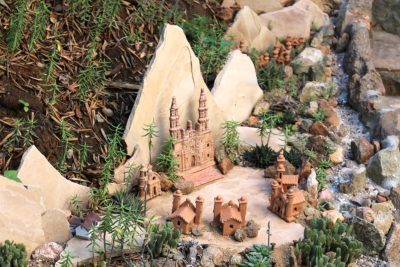
Cuttings of Crassula tetragona make little buildings look huge. (From Designing with Succulents.)
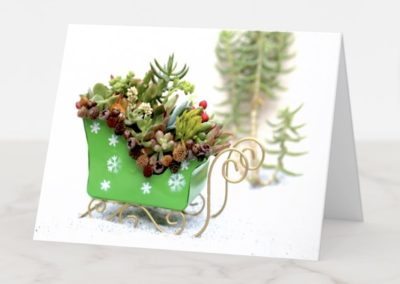
I used Crassula tetragona as a backdrop for my Succulent Sleigh greeting card. Find this and other succulent greeting cards at Succulent Chic, my online Zazzle store.
Like many succulents, new leaves grow from the tops of the stems and old leaves wither and fall off. Eventually you're left with naked stems topped with clusters of leaves. If you prefer a fuller look, prune once a year to make stems branch. Or if you're a lazy gardener like me, simply stick a metal fish in their midst.

An ornamental garden fish made from repurposed materials looks right at home amid my overgrown Crassula tetragona.
Do you grow this succulent yourself? Have you used it in seasonal displays or in a miniature landscape? Do let us know in the comments below!
Related info on this site
Crassula (Jade and More): Details, Photos and Varieties
Crassulas are among the easiest, most trouble-free succulents to grow, with one caveat: With few exceptions, they’re frost-tender (tend to be damaged when temperatures drop below 32 degrees F). Shrub varieties are very easy to start from cuttings, and stacked jades will send forth whiskery roots from between their tight leaves—simply snip off the stem and bury in potting soil so that roots are covered (it’s OK to bury a few leaves too). Crassulas, like aloes, also stress beautifully to shades of red, yellow and orange. Give variegated varieties adequate sun or they’ll revert to solid green.

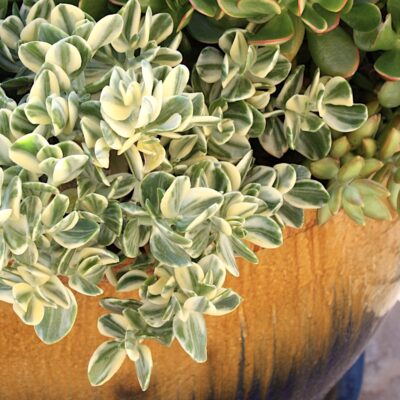
Are these crassulas above dormant in the summer or winter? How often do you water them? When do feed them and with what? Are there any books that comment on the cultivation?
Hi Charlene — Yes indeed. All three of my books as well as the Crassula page of this site give information about the genus, which like most South African succulents are winter-dormant. But first see general cultivation requirements for succulents, which apply to crassulas (see “Succulent Care Basics”), where you’ll find info on water, fertilizer and more. Thanks for asking!
I have many in both mostly full sun and mostly shade. They do well with hardly any supplemental water to weekly watering depending on the weather and sun exposure. As Debra said, they grow anywhere jades grow with similar water requirements. I have never accidentally killed any, and they multiply without encouragement and grow easily from cuttings. I have some that have been fed once or at most twice year, and others that I have never fed. They don’t seem to need fertilizer in my garden. For reference, I live on a rocky ridge at 1700’ above canyons in east San Diego with sun exposure and wind from all angles. It rarely gets below the mid thirties. I have not encountered frost damage.
They can continue to grow year round in mild temps. They may drop some leaves in cooler temps. They can handle drought watering once they are over a few years old. Very hardy grower. Dainty flowers emerge in spring and mild summers. Attracts bumble bees and even large black carpenter bees. Great for pollinators.
Debra:
I made some really darling pumpkin/succulent arrangements for Christmas, a couple using crassulas, and I glued tiny little baubles from old jewelry I had accumulated over the years. In Sausalito, with freezing cold wind and fog all summer, my crassulas thrive. Your Christmas designs are so sweet. I will be stealing some of your ideas!
Cathy
Thanks, Cathy. By all means “steal” and have fun with my any of my ideas that inspire you. That’s what makes it all worthwhile!
Hi Debra,
I have this one growing in hot hot Ramona, with no extra water. And we get night time frost. Yet it grows and multiplies like anything.
My question is, I need to trim it. But the lower parts are just sticks. How do I trim it nicely? I can add a picture but I don’t know if that’s allowed.
I’ve learned a lot from you in the past years, thank you.